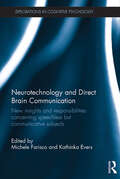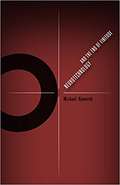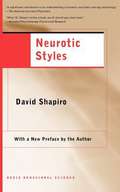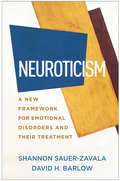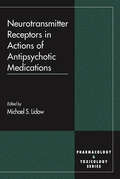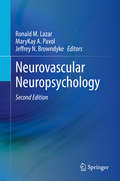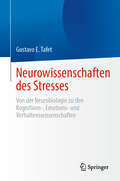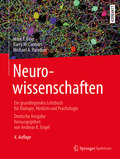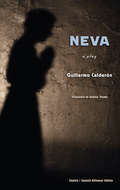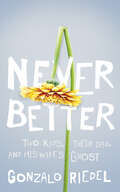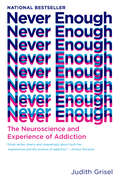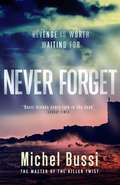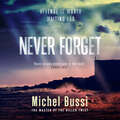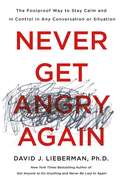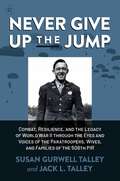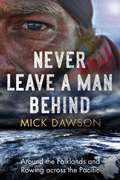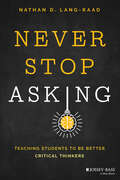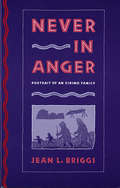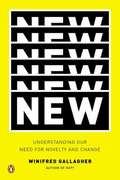- Table View
- List View
Neurotechnology and Direct Brain Communication: New insights and responsibilities concerning speechless but communicative subjects (Explorations in Cognitive Psychology)
by Michele Farisco Kathinka EversNeurotechnology and Direct Brain Communication focuses on recent neuroscientific investigations of infant brains and of patients with disorders of consciousness (DOC), both of which are at the forefront of contemporary neuroscience. The prospective use of neurotechnology to access mental states in these subjects, including neuroimaging, brain simulation, and brain computer interfaces, offers new opportunities for clinicians and researchers, but has also received specific attention from philosophical, scientific, ethical, and legal points of view. This book offers the first systematic assessment of these issues, investigating the tools neurotechnology offers to care for verbally non-communicative subjects and suggesting a multidisciplinary approach to the ethical and legal implications of ordinary and experimental practices. The book is divided into three parts: the first and second focus on the scientific and clinical implications of neurological tools for DOC patient and infant care. With reference to these developments, the third and final part presents the case for re-evaluating classical ethical and legal concepts, such as authority, informed consent, and privacy. Neurotechnology and Direct Brain Communication will appeal to researchers and postgraduate students in the fields of cognitive science, medical ethics, medical technology, and the philosophy of the mind. With implications for patient care, it will also be a useful resource for clinicians, medical centres, and health practitioners.
Neurotechnology and the End of Finitude (Posthumanities #45)
by Michael HaworthA bold philosophical investigation into technology and the limits of the human A daring, original work of philosophical speculation, Neurotechnology and the End of Finitude mounts a sustained investigation into the possibility that human beings may technologically overcome the transcendental limits of possible experience and envisages what such a transition would look like. Focusing on emergent neurotechnologies, which establish a direct channel of communication between brain and machine, Michael Haworth argues that such technologies intervene at the border between interiority and exteriority, offering the promise of immediacy and the possibility of the mind directly affecting the outside world or even other minds. Through detailed, targeted readings of Kant, Freud, Heidegger, Croce, Jung, and Derrida, Haworth explores the effect of this transformation on human creativity and our relationships with others. He pursues these questions across four distinct but interrelated spheres: the act of artistic creation and the potential for a technologically enabled coincidence of idea and object; the possibility of humanity achieving the infinite creativity that Kant attributed only to God; the relationship between the psyche and the external world in Freudian psychoanalysis and Jungian analytical psychology; and the viability and impact of techno-telepathic communication. Addressing readers interested in contemporary continental philosophy and philosophy of technology, media and communications, and science and technology studies, Neurotechnology and the End of Finitude critically envisions a plausible posthuman future.
Neurotheology: How Science Can Enlighten Us About Spirituality (Routledge Science And Religion)
by Andrew NewbergReligion is often cast in opposition to science. Yet both are deeply rooted in the inner workings of the human brain. With the advent of the modern cognitive neurosciences, the scientific study of religious and spiritual phenomena has become far more sophisticated and wide-ranging. What might brain scans of people in prayer, in meditation, or under the influence of psychoactive substances teach us about religious and spiritual beliefs? Are religion and spirituality reducible to neurological processes, or might there be aspects that, at least for now, transcend scientific claims?In this book, Andrew Newberg explores the latest findings of neurotheology, the multidisciplinary field linking neuroscience with religious and spiritual phenomena. He investigates some of the most controversial—and potentially transformative—implications of a neurotheological approach for the truth claims of religion and our understanding of minds and brains. Newberg leads readers on a tour through key intersections of neuroscience and theology, including the potential evolutionary basis of religion; the psychology of religion, including mental health and brain pathology; the neuroscience of myths, rituals, and mystical experiences; how studies of altered states of consciousness shed new light on the mind-brain relationship; and what neurotheology can tell us about free will. When brain science and religious experience are considered together in an integrated approach, Newberg shows, we might come closer to a fuller understanding of the deepest questions.
Neurotherapy and Neurofeedback: Brain-Based Treatment for Psychological and Behavioral Problems
by Lori A. Russell-Chapin Theodore J. ChapinThe fields of neurobiology and neuropsychology are growing rapidly, and neuroscientists now understand that the human brain has the capability to adapt and develop new living neurons by engaging new tasks and challenges throughout our lives, essentially allowing the brain to rewire itself. In Neurotherapy and Neurofeedback, accomplished clinicians and scholars Lori Russell-Chapin and Ted Chapin illustrate the importance of these advances and introduce counselors to the growing body of research demonstrating that the brain can be taught to self-regulate and become more efficient through neurofeedback (NF), a type of biofeedback for the brain. Students and clinicians will come away from this book with a strong sense of how brain dysregulation occurs and what kinds of interventions clinicians can use when counseling and medication prove insufficient for treating behavioral and psychological symptoms.
Neurotic Styles (The Austen Riggs Center Monograph Series #No.5)
by David ShapiroThis new edition of one of the books most closely identified with clinical psychology since 1965 will expose a new generation to Shapiro's stunningly defining conceptualizations of the Obsessive-Compulsive, Paranoid, Hysterical, and Impulsive ways of being.
Neuroticism: A New Framework for Emotional Disorders and Their Treatment
by David H. Barlow Shannon Sauer-ZavalaNeuroticism--the tendency to experience negative emotions, along with the perception that the world is filled with stressful, unmanageable challenges--is strongly associated with anxiety, depression, and other common mental health conditions. This state-of-the-art work shows how targeting this trait in psychotherapy can benefit a broad range of clients and reduce the need for disorder-specific interventions. The authors describe and illustrate evidence-based therapies that address neuroticism directly, including their own Unified Protocol for transdiagnostic treatment. They examine how neuroticism develops and is maintained, its relation to psychopathology, and implications for how psychological disorders are classified and diagnosed.
Neurotransmitter Receptors in Actions of Antipsychotic Medications (Handbooks in Pharmacology and Toxicology)
by Michael S. LidowYears of extensive investigation into neurophysiology, neurochemistry, and behavioral pharmacology have produced an understanding of antipsychotic medication action that is much more refined than the original dopamine hypothesis. New perspectives offer an array of novel drugs - drugs that pose a lower risk of developing tardive dyskinesia, have few
Neurovascular Neuropsychology
by Joanne Festa Ronald Lazar J. P. MohrNeurovascular diseases and conditions, and their associated risk factors, represent a significant cause of cognitive disability in the United States and throughout the world. In the USA alone there are 750,000 new strokes each year, representing the number one cause of disability in the country. Hypertension, found in approximately 50 million Americans, has been shown to be associated with alterations of cognitive function, even in the absence of stroke and dementia. Recent studies of neurovascular disease have now revealed that neuropsychological function may be a more sensitive measure of brain integrity than coordination, motor or sensory function and correlates will with functional outcome measures. Neurovascular Neuropsychology focuses on focal and diffuse neurovascular disease in addition to systemic conditions in which cognition and behavior have been uniquely associated with different pathologic states. With an increasing number of patients being treated by healthcare professionals, Neurovascular Neuropsychology will prove to be a strong reference to consult in regards to neuropsychological syndromes.
Neurovascular Neuropsychology
by Ronald M. Lazar MaryKay A. Pavol Jeffrey N. BrowndykeThis book covers the explosion of new information about the relationship between the brain and its blood supply since the first edition was published in 2009. With new knowledge and its impact on clinical care, neurovascular neuropsychology has become a recognized sub-specialty that has been integrated into health care systems in the US and abroad. The second edition brings to this larger audience the latest word on these matters, with new emphasis on women’s issues, relevance to the pediatric population, insights from modern imaging, and advances in medical and surgical treatments such as heart transplantation, cardiovascular transarterial therapies, and noninvasive brain stimulation in connection with neurocognitive outcomes.
Neurowissenschaften des Stresses: Von der Neurobiologie zu den Kognitions-, Emotions- und Verhaltenswissenschaften
by Gustavo E. TafetDieses Lehrbuch bietet eine Einführung in das interdisziplinäre Studium von Stress und hilft Studierenden und Fachleuten, die wichtigsten neurobiologischen und psychologischen Ursachen und Folgen von Stress beim Menschen zu verstehen. Es zielt darauf ab, das Konzept von Stress auf verschiedenen Ebenen zu verstehen, von den Auswirkungen von Umweltstressoren bis zu seiner Verarbeitung im Gehirn und von den neuronalen Mechanismen, die an dieser Verarbeitung beteiligt sind, bis zum Ausdruck verschiedener adaptiver Reaktionen. Alle diese neuronalen Mechanismen werden auf verschiedenen Komplexitätsebenen klar erläutert, von der neurobiologischen Ebene, einschließlich der zellulären und molekularen Mechanismen, bis zur psychologischen Ebene, einschließlich der kognitiven und emotionalen Verarbeitung und der Verhaltensäußerungen.Der Inhalt ist fundiert und wird von anschaulichen Grafiken begleitet, die Details sehr hilfreich verdeutlichen und somit eine vollständige Integration aller dargestellten Konzepte ermöglichen. Darüber hinaus werden klinische Ausdrucksformen von Stress, wie z.B. Stimmungs- und Angststörungen, ausführlich behandelt. Auch erhalten Sie einen Überblicks über verschiedene Faktoren der Anfälligkeit und Widerstandsfähigkeit, wodurch ein einzigartiger und grundlegender Einblick in dieses interdisziplinäre Gebiet geboten wird. Aufgrund seines interdisziplinären Ansatzes bietet Neuroscience of Stress: From Neurobiology to Cognitive, Emotional and Behavioral Sciences (Von der Neurobiologie zu den Kognitions-, Emotions- und Verhaltenswissenschaften) Studierenden und Fachleuten aus verschiedenen Bereichen der Verhaltens- und Gesundheitswissenschaften eine umfassende und klare Einführung in die Erforschung von Stress und ist bestens geeignet für den Einsatz in einer Vielzahl von Studiengängen, die sich mit psychischer Gesundheit und Wohlbefinden befassen, u. a. in den Bereichen Gesundheit und klinische Psychologie, Gesundheitsförderung undKrankheitsprävention, Psychiatrie und Verhaltensmedizin.
Neurowissenschaften: Ein Grundlegendes Lehrbuch Für Biologie, Medizin Und Psychologie
by Mark F. Bear Michael A. Paradiso Monika Niehaus-Osterloh Barry W. Connors Andreas K. Engel Andreas HeldDer perfekte Einstieg in die Neurowissenschaften – ideal zum Verstehen und LernenSeit vielen Jahren zählt diese didaktisch durchdachte, verständlich geschriebene und hervorragend illustrierte Einführung international zu den führenden Lehrbüchern im Bereich der Neurowissenschaften. Das moderne Grundlagenwerk richtet sich an Studierende der Biologie, der Medizin und der Psychologie gleichermaßen. Die wieder von Andreas Engel herausgegebene deutsche Ausgabe ist an die hiesige Studiensituation angepasst und stellenweise erweitert. Der Bogen spannt sich von der Anatomie des Gehirns bis zur Sinnesphysiologie, von der Entwicklungsbiologie bis zum Verhalten, von den Störungen des Nervensystems bis zur Kognitionswissenschaft, von den molekularen Mechanismen bis zu den neuen bildgebenden Verfahren. Ein eigenständiger „Bildatlas der menschlichen Neuroanatomie“ erlaubt dem Lernenden, seine Kenntnisse der Hirnstrukturen zu überprüfen und zu erweitern. Jedes Kapitel endet mit Verständnisfragen und Übungsaufgaben sowie einer Zusammenstellung wichtiger weiterführender Literatur. In spannenden Exkursen berichten renommierte Wissenschaftler, wie sie zu ihren entscheidenden Entdeckungen kamen. So führt das Buch den Leser von den Grundlagen zu den aktuellen Forschungsthemen des Faches.In der durchgehend aktualisierten 4. Auflage sind unter anderem neue Forschungsergebnisse zu Optogenetik, Konnektomik, tiefer Hirnstimulation, molekularer Medizin und Neuroökonomie eingearbeitet worden. Zahlreiche neue oder aktualisierte Abbildungen veranschaulichen in bewährter Manier die im Text beschriebenen Prozesse, Strukturen und Methoden. Wer Neurowissenschaften in ihrer ganzen Bandbreite verstehen will, ist mit "dem Bear" bestens bedient. Den drei Verfassern des Buches gelingt, womit Lehrbuchautoren im deutschsprachigen Raum sich nach wie vor schwer tun: anschaulich und spannend den Leser vom Einstieg in die Grundlagen bis an die vorderste Front der Forschung mitzunehmen und ohne überflüssigen Ballast wissenschaftliche Erkenntnis mehr erzählend als erklärend zu vermitteln … Ein didaktisches Meisterwerk ist nun topaktuell auch in deutscher Sprache neu aufgelegt verfügbar. Aus dem Vorwort von Prof. Andreas K. Engel, Universitätsklinikum Hamburg-Eppendorf
Neva: English/Spanish
by Guillermo Calderón Andrea Thome"Guillermo Calderón is an authentic genius of the theater . . . you can't say you've heard or seen any of it before, which may make you want to hear and see it again."--The New Yorker"Neva's neobrutalist punch demonstrates . . . the enduring power of art."--Time Out New York"Brilliant and provocative."--TheatreMania"A lovely, disturbing drama . . . Calderón's drama is Chekhovian in the best sense."--The Village VoiceThis politically charged, haunting yet humorous meditation on theater and the revolutionary impulse tells the story of three actors, including Anton Chekhov's widow, who gather to rehearse scenes from The Cherry Orchard as Russia faces an impending revolution. A savage examination of the relationship between theater and historical context, Neva is the author's first play, which he directed for its English language premiere at the Public Theater in New York City.Guillermo Calderon is Chile's foremost contemporary theater artist. His plays include Diciembre (December), Clase (Class), Villa, Discurso (Speech), Quake, and Escuela (School), and his productions have toured extensively through South America and Europe. His co-written screenplay Violeta won the World Cinema Jury Prize for Drama at the 2012 Sundance Film Festival, and other awards include Best Play of the Year (Art Critics Circle of Chile), three Chilean Altazor Awards for Best Playwright and Best Director, and the 2010 Bank of Scotland Angel Award (Edinburgh Fringe Festival).
Never Better: Two Kids, Their Dad, and His Wife's Ghost
by Gonzalo RiedelHis wife died before their second son turned one. How can he keep her memory alive when there’s so much he wants to forget?There was a time before his wife got sick when Gonzalo could think about other things. They had full lives where death didn’t factor. Where humour was more than a coping mechanism. Life wasn’t all about treatments and recovery, or the emptiness he felt when she died.They had kids together. Young kids. Less than a year after their youngest was born and suddenly he was strapping them both into their car seats to drive to their mother’s funeral.He used to think he was the glue holding the household together. It didn’t take long for him to realize how wrong he’d been. A grieving husband is in no condition to raise kids alone. There were times when he wanted to toss himself into a raging river that would suck him under and bash his skull on the rocks. That’s always an option for another day. For now, he’ll just squash those feelings and drive the kids to daycare.Does it get easier? Of course. But not right away. They say that hope only comes at the end of a long dark journey, but that isn’t entirely true because the journey never really ends. But that means there’s good news: hope is everywhere you look.
Never Enough: The Neuroscience and Experience of Addiction
by Judith GriselFrom a renowned behavioral neuroscientist and recovered drug addict, an authoritative and accessible guide to understanding drug addiction: clearly explained brain science and vivid personal stories reveal how addiction happens, show why specific drugs--from opioids to alcohol to coke and more--are so hard to kick, and illuminate the path to recovery for addicts, loved ones, caregivers, and crafters of public policy.Addiction is epidemic and catastrophic. With more than one in every five people over the age of fourteen addicted, drug abuse has been called the most formidable health problem worldwide. If we are not victims ourselves, we all know someone struggling with the merciless compulsion to alter their experience by changing how their brain functions. Drawing on years of research--as well as personal experience as a recovered addict--researcher and professor Judy Grisel has reached a fundamental conclusion: for the addict, there will never be enough drugs. The brain's capacity to learn and adapt is seemingly infinite, allowing it to counteract any regular disruption, including that caused by drugs. What begins as a normal state punctuated by periods of being high transforms over time into a state of desperate craving that is only temporarily subdued by a fix, explaining why addicts are unable to live either with or without their drug. One by one, Grisel shows how different drugs act on the brain, the kind of experiential effects they generate, and the specific reasons why each is so hard to kick. Grisel's insights lead to a better understanding of the brain's critical contributions to addictive behavior, and will help inform a more rational, coherent, and compassionate response to the epidemic in our homes and communities.
Never Enough: When Achievement Culture Becomes Toxic—and What We Can Do About It
by Jennifer Breheny WallaceThe definitive book on the rise of “toxic achievement culture” overtaking our kids' and parents' lives, and a new framework for fighting back. <p><p> In the ever more competitive race to secure the best possible future, today’s students face unprecedented pressure to succeed. They jam-pack their schedules with AP classes, fill every waking hour with resume-padding activities, and even sabotage relationships with friends to “get ahead.” Family incomes and schedules are stretched to the breaking point by tutoring fees and athletic schedules. Yet this drive to optimize performance has only resulted in skyrocketing rates of anxiety, depression, and even self-harm in America’s highest achieving schools. Parents, educators, and community leaders are facing the same quandary: how can we teach our kids to strive towards excellence without crushing them? <p><p> In Never Enough, award-winning reporter Jennifer Breheny Wallace investigates the deep roots of toxic achievement culture, and finds out what we must do to fight back. Drawing on interviews with families, educators, and an original survey of nearly 6,000 parents, she exposes how the pressure to perform is not a matter of parental choice but baked in to our larger society and spurred by increasing income inequality and dwindling opportunities. As a result, children are increasingly absorbing the message that they have no value outside of their accomplishments, a message that is reinforced by the media and greater culture at large. <p><p> Through deep research and interviews with today’s leading child psychologists, Wallace shows what kids need from the adults in the room is not more pressure, but to feel like they matter, and have intrinsic self-worth not contingent upon external achievements. Parents and educators who adopt the language and values of mattering help children see themselves as a valuable contributor to a larger community. And in an ironic twist, kids who receive consistent feedback that they matter no matter what are more likely to have the resilience, self-confidence, and psychological security to thrive. <p><p> Packed with memorable stories and offering a powerful toolkit for positive change, Never Enough offers an urgent, humane view of the crisis plaguing today’s teens and a practical framework for how to help. <p> <b>New York Times Bestseller</b>
Never Forget: The #1 bestselling novel by the master of the killer twist
by Michel BussiA #1 INTERNATIONAL BESTSELLER A SUNDAY TIMES CRIME BOOK OF THE MONTH'Outrageously entertaining' The Times'A tantalising story that wraps the reader in myriad enigmas - utterly spellbinding'Daily Mail'As exhilarating as Bussi's breakthrough novel After the Crash' The Sunday Times 'Agatha Christie updated and then cranked up to 11: a blast' Shots Magazine REVENGE IS WORTH WAITING FOR... Jamal loves to run. But one morning - as he is training on a path winding up a steep cliff - he stumbles across a woman in distress.It's a matter of seconds: suddenly she is falling through the air, crashing on the beach below.Jamal is only an unlucky bystander - or is he?His version of events doesn't seem to fit with what other eyewitnesses claim to have seen. And how to explain the red scarf carefully arranged around the dead woman's neck?Perhaps this was no accident after all.Or perhaps there is something more sinister afoot - a devilish plan decades in the making, masterminded by someone hell-bent on revenge.MICHEL BUSSI: THE MASTER OF THE KILLER TWISTBeloved by readers... 'I didn't anticipate all the twists and turns in this cleverly plotted novel''The final twist is a bit of a jaw dropper''Twists and turns aplenty!''A twisting, turning story which clobbers you with a number of cracking twists!''Fast-paced and chock full of twists, turns and red herrings' ...and critics 'A novel so extraordinary that it reminded me of reading Steig Larsson for the very first time . . . I doubt I'll read a more brilliant crime novel this year' Sunday Times on After the Crash'A dazzling, unexpected and haunting masterpiece' Daily Mail on Black Water Lilies'Inventive, original and incredibly entertaining' Sunday Mirror on Don't Let Go'Combines an extraordinarily inventive plot with characters haunted by long-ago events - and demonstrates why he has such a hold on readers' Sunday Times on Time is a Killer
Never Forget: The #1 bestselling novel by the master of the killer twist
by Michel BussiA #1 INTERNATIONAL BESTSELLERA SUNDAY TIMES CRIME BOOK OF THE MONTH'Outrageously entertaining' The Times'Utterly spellbinding' Daily Mail'As exhilarating as Bussi's breakthrough novel After the Crash' The Sunday Times'Agatha Christie updated and then cranked up to 11: a blast' Shots MagazineJamal loves to run. But one morning - as he is training on a path winding up a steep cliff - he stumbles across a woman in distress. It's a matter of seconds: suddenly she is falling through the air, crashing on the beach below.Jamal is only an unlucky bystander - or is he? His version of events doesn't seem to fit with what other eyewitnesses claim to have seen. And how to explain the red scarf carefully arranged around the dead woman's neck? Perhaps this was no accident after all. Or perhaps there is something more sinister afoot - a devilish plan decades in the making, masterminded by someone hell-bent on revenge.
Never Get Angry Again: The Foolproof Way to Stay Calm and in Control in Any Conversation or Situation
by Dr David J. LiebermanNever Get Angry Again is New York Times and internationally bestselling author David J. Lieberman's comprehensive, holistic look at the underlying emotional, physical, and spiritual causes of anger, and a practical guide to what the reader can do to gain perspective.David J. Lieberman understands that a change in perspective is all that is needed to help keep from flying off the handle. In Never Get Angry Again, he reveals how to see anger through a comprehensive, holistic lens, illuminates the underlying emotional, spiritual, and physical components of anger, and gives the readers simple, practical tools to snuff out anger before it even occurs.Take a deep breath and count to ten. Meditate. Visualize your happy place. You’ve probably heard all of these anger management techniques and more from friends, family, and experts, but somehow they miss the mark when it comes to coping with the complex emotion of anger. Let’s face it: if anger-management techniques were effective, you wouldn’t be reading this book. These clumsy attempts to maintain calmness are usually futile and sometimes emotionally draining. The fact is, either something bothers us (causing anxiety, frustration, or anger), or it doesn’t. A state of calm is better accomplished by not becoming agitated in the first place. When we fight the urge to blow up or melt down, we fight against our own nature.
Never Give Up the Jump: Combat, Resilience, and the Legacy of World War II through the Eyes and Voices of the Paratroopers, Wives, and Families of the 508th PIR
by Susan Gurwell Talley Jack L. TalleyThe daughter of a D-Day paratrooper and her husband, a PTSD therapist, discover a family legacy of love, trauma, and resilience when they set out to explore a vast trove of WWII correspondence, official military documents, personal effects, and unique militaria found in closets and basements after her father&’s death.Young Sue Gurwell had always known that her father had been a paratrooper. An old camo parachute from Holland served as her backyard tent, and high on a shelf she mustn&’t touch, eight red devils in parachutes grinned from the front of mysterious drinking glasses Dad had sent Mom during the war. And then there was the special poem in his roll-top desk she sometimes snuck a peek at, written by a member of Dad&’s regiment. This poem was a premonition of the sergeant&’s death. &“Yes,&” her dad told her, &“He was right—he died on D-Day.&” But it&’s not until 2016, after her parents had both passed away, that Susan Gurwell Talley and her husband Jack L. Talley begin to understand the true extent and significance of the wartime artifacts that had been staples of Sue&’s childhood. The Talley&’s discovered that Sue&’s father, Lt. George L. Gurwell, Executive Officer, HqHq, 508th PIR, had silently squirreled away thousands of wartime documents in the family home. Like most combat veterans, George was never one to talk about the war; but the historic collection of official records, correspondence, photographs, maps, memorabilia, cultural artifacts, and unique ephemera constitute quite possibly the most extensive, various, and complete documentation of the 508th held privately today. This precious resource could not have passed into better hands than those of Jack and Sue Talley. Jack, a PhD psychologist specializing in PTSD, was the first to understand that George had PTSD symptoms that still lingered from the war years when he and George were introduced on June 6, 2001. That evening, the 57th anniversary of D-Day, George first opened up about the war, and preceded to talk late into the night. In that conversation lies the genesis of this book.
Never Leave a Man Behind: Around the Falklands and Rowing across the Pacific
by Mick Dawson'Mick Dawson's gripping Never Leave A Man Behind, effectively two adventure stories for the price of one, can be justifiably described as "unputdownable". Dawson is a man you would want on your side, whether in battle or tackling waves as high as houses should you ever consider rowing the Pacific.'Sports Book of the Month'An excellent read, it puts you in the boat, understanding what it's like to be in an extremely challenging environment while maintaining composure, cheerfulness and respect for your fellow men. I cannot recommend it highly enough'Keith M. Breslauer, Trustee of The Royal Marines Charity'Breathtaking - builds tension from the very start with life-and-death challenges throughout. Courage and comradeship at their very best, showing how mental and physical disabilities cannot and are not allowed to define or undermine the human self. Leaves you in awe and respect for one man determined to help his muckers win their battles whatever it takes - at great personal cost'Jonathan Ball, Director, The Royal Marines CharityThe stories of two veterans - one traumatised, one blind - who rediscover themselves with the help of a friend in the course of two epic ocean adventures, kayaking around the Falklands and rowing across the Pacific.Mick Dawson tells the story of kayaking around the Falkland Islands with friend and fellow Royal Marines veteran Steve Grenham, who was struggling to cope with the effects of Post-Traumatic Stress Disorder (PTSD), and the extraordinary tale of his 2,500-mile voyage in a rowing boat with his friend and former Royal Marine Commando Steve 'Sparky' Sparkes, who was not only a rowing novice, but also blind. Sparky and Mick succeeded in rowing across the finish line after a truly epic voyage of over 2,500 miles from Monterey Bay in California to Waikiki, Hawaii. They'd hoped to break the record for a two-man rowboat and finish in less than fifty-five days, but a hurricane interfered with their plans. It took them eighty-two days, sixteen hours and fifty-four minutes to complete the race, but it was an even greater achievement for that, and Sparky became the first visually impaired person to row across the Pacific.The race with Sparky was the second expedition of an organisation Mick had set up a few years earlier, The Cockleshell Endeavour, designed to help another former Royal Marine and friend, Steve Grenham, by kayaking with him around the Falklands, where both former commandos served during the 1982 conflict with Argentina.
Never Leave a Man Behind: Around the Falklands and Rowing across the Pacific
by Mick Dawson'Mick Dawson's gripping Never Leave A Man Behind, effectively two adventure stories for the price of one, can be justifiably described as "unputdownable". Dawson is a man you would want on your side, whether in battle or tackling waves as high as houses should you ever consider rowing the Pacific.'Sports Book of the Month'An excellent read, it puts you in the boat, understanding what it's like to be in an extremely challenging environment while maintaining composure, cheerfulness and respect for your fellow men. I cannot recommend it highly enough'Keith M. Breslauer, Trustee of The Royal Marines Charity'Breathtaking - builds tension from the very start with life-and-death challenges throughout. Courage and comradeship at their very best, showing how mental and physical disabilities cannot and are not allowed to define or undermine the human self. Leaves you in awe and respect for one man determined to help his muckers win their battles whatever it takes - at great personal cost'Jonathan Ball, Director, The Royal Marines CharityThe stories of two veterans - one traumatised, one blind - who rediscover themselves with the help of a friend in the course of two epic ocean adventures, kayaking around the Falklands and rowing across the Pacific.Mick Dawson tells the story of kayaking around the Falkland Islands with friend and fellow Royal Marines veteran Steve Grenham, who was struggling to cope with the effects of Post-Traumatic Stress Disorder (PTSD), and the extraordinary tale of his 2,500-mile voyage in a rowing boat with his friend and former Royal Marine Commando Steve 'Sparky' Sparkes, who was not only a rowing novice, but also blind. Sparky and Mick succeeded in rowing across the finish line after a truly epic voyage of over 2,500 miles from Monterey Bay in California to Waikiki, Hawaii. They'd hoped to break the record for a two-man rowboat and finish in less than fifty-five days, but a hurricane interfered with their plans. It took them eighty-two days, sixteen hours and fifty-four minutes to complete the race, but it was an even greater achievement for that, and Sparky became the first visually impaired person to row across the Pacific.The race with Sparky was the second expedition of an organisation Mick had set up a few years earlier, The Cockleshell Endeavour, designed to help another former Royal Marine and friend, Steve Grenham, by kayaking with him around the Falklands, where both former commandos served during the 1982 conflict with Argentina.
Never Stop Asking: Teaching Students to be Better Critical Thinkers
by Nathan D. Lang-RaadThe modern K-12 teacher's must-have guide to teach students how to ask questions, weigh the evidence, and think critically and independently Students and teachers alike face a dilemma: Why think deeply when we can just take a shortcut by googling something? Why read an article when we can learn from a social media headline? If, as educators, we want to encourage our students to value thoughtfulness and to embrace the effort it takes to reach deep understandings, we must model that behavior ourselves. In Never Stop Asking, author Dr. Nathan Lang-Raad shows K-12 teachers how human brains like to take mental shortcuts, known as heuristics, that allow the brain to save energy and perform more efficiently. These heuristics, however, can lead to illogical thinking, cognitive biases, and fallacies that can hinder critical thinking. Never Stop Asking: Teaching Students to be Better Critical Thinkers is the armor we need to defend ourselves and our students against the all-too-tempting shortcuts that the digital age has to offer, employing strategies to consistently and explicitly support teaching critical thinking and weaving it into the everyday landscape of your classroom. Let’s ensure that the students of today will be the skilled thinkers of tomorrow. Learn about common psychological shortcuts and biases that hinder students and teachers alike Discover the logic and the science behind critical thinking and why it leads to better outcomes Gain strategies to bring critical thinking into the classroom and help students build patience, discipline, and skill Acknowledge and embrace the digital age in your teaching—without falling victim to its downsidesThis is an engaging and important book for K-12 teachers and instructional coaches. Teacher training programs can also be enhanced by the practical wisdom and easy-to-implement strategies inside.
Never in Anger: Portrait of an Eskimo Family
by Jean L. BriggsIn the summer of 1963, anthropologist Jean Briggs journeyed to the Canadian Northwest Territories (now Nunavut) to begin a seventeen-month field study of the Utku, a small group of Inuit First Nations people who live at the mouth of the Back River, northwest of Hudson Bay. Living with a family as their “adopted” daughter—sharing their iglu during the winter and pitching her tent next to theirs in the summer—Briggs observed the emotional patterns of the Utku in the context of their daily life. In this perceptive and highly enjoyable volume the author presents a behavioral description of the Utku through a series of vignettes of individuals interacting with members of their family and with their neighbors. Finding herself at times the object of instruction, she describes the training of the child toward achievement of the proper adult personality and the handling of deviations from this desired behavior.
Never the Same: Coming to Terms with the Death of a Parent
by Donna SchuurmanChildren and teens who experience the death of a parent are never the same. Only in the last decade have counselors acknowledged that children grieve too, and that unresolved issues can negatively impact children into adulthood. Unaddressed grief can lead to depression, substance abuse, and relationship difficulties. For at least three generations of adults, these issues have been largely ignored. Having worked with thousands of families as Executive Director of the Dougy Center for Grieving Children, Donna Schuurman understands the dangers of unresolved grief better than anyone else. In Never the Same, Schuurman offers expert advice and encouragement to empower readers to reflect on their unique situation, come to terms with the influence of their parent's death, and live more healthful, peaceful lives.The only book of its kind, Never the Same is an essential companion for those still struggling with the early loss of a parent.
New
by Winifred GallagherAn exploration of how humans respond to novelty from the New York Times-bestselling author of Rapt Why are we attuned to the latest headline, diet craze, smartphone, and fashion statement? Why do we relish a change of scene, eye attractive strangers, and develop new interests? Follow a crawling baby around and you'll see that right from the beginning, nothing excites us more than something new and different. Our unique human brains are biologically primed to engage with and even generate novelty. This "neophilia" has enabled us to thrive in a world of cataclysmic change, but now we confront an unprecedented deluge of new things--one that shows no sign of slowing. In New acclaimed behavioral science writer Winifred Gallagher, using cutting-edge research and interviews with countless experts, shows us how we can use our adaptive gift to navigate more skillfully through our rapidly changing world by focusing on the new things that really matter.
